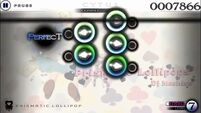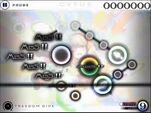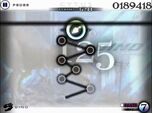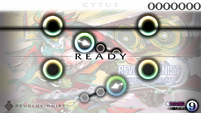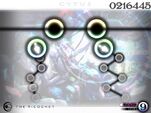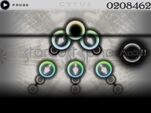No edit summary |
No edit summary |
||
| (27 intermediate revisions by 19 users not shown) | |||
| Line 1: | Line 1: | ||
| + | Drag notes are small notes connected to each other by a track, that can be followed by dragging along its path as the scan line moves. The track starts with an arrow determining the direction to the next note. Note that these tracks do not continue over between scrolls of the scan line (except for horizontal tracks in [[Cytus II]]). Rather, a new track is formed when a path is continued over to a new scan line page. |
||
| − | [[File:Drag_note.jpg|thumb|Example of Drag notes |
||
| − | From Google]]Drag notes are notes connected to each other that can be followed by dragging its path as the scan line moves. The track is actually a set of small notes scored individually (the score of one small note is the score of the normal-sized note, divided by the number of small notes). The track starts with an arrow determining the direction to the next note. Notice that these tracks last only once while the scan line goes back and forth. Instead, it is set with another track (ex. [[Freedom Dive]]). |
||
| + | {|class="article-table" |
||
| − | Some of the noticeable and known drag notes' tracks are: |
||
| + | |- |
||
| − | * Zigzag tracks- These tracks make mostly Lvl 9 songs hard to master. It may be narrow (ex. [[Zauberkugel]]), wide (ex. [[Halloween Party]]), unequal (ex. [[Dino]]), or multiple (ex. [[∅ (Slit) I]]). The double-note zigzags can be done easily using a trick (place two fingers at alternating notes and follow the scan line; these act like two perpendicular multiple-note straight tracks; this cannot be done on multiple note zigzags cause they have notes between the two alternating vertices of the track). Difficult zigzag tracks can include the slanted tracks from [[∅ (Slit) I]], and in this case, there are three dots to move across before moving in the other direction, so you can use three fingers to make it easy. |
||
| + | !align="center" colspan="2"|SOME NOTICEABLE DRAG NOTE TRACKS |
||
| − | * Slant tracks- These tracks make up almost every level. It may be steep (ex. [[Morpho]]), very (but not) flat (ex. [[Prismatic Lollipops]]), or from corner to corner (ex. [[Holy Knight]]). These tracks are easy even in very fast scan lines. |
||
| + | |- |
||
| − | * Alternating tracks- These tracks are separated and usually have the same length but not the same direction. The best example for this is [[Prismatic Lollipops]]. |
||
| + | !Straight Tracks |
||
| − | * Back-and-forth tracks- These tracks may not be connected, but they act like one. They are either the same (ex. [[L2 - Ascension: Act 2 (Liberation)]]) or random (ex. [[Entrance]]). They also make most of Lvl 9s. It may not be necessary to follow the whole track using one hand only. You can swap hands once you reach the end of one track and start on another continous track using the other hand. |
||
| + | |These are the simplest tracks in the game, only travelling in a vertical line up or down the scan line. They can range in length and density, and they can also be used in combination with other note types (ex. [[Requiem]]'s beginning). |
||
| − | * Curved tracks- these tracks can be found on any level. These are the soothest tracks since they don't have rough edges(mostly zigzags). A good example of this is [[L2 - Ascension: Act 1 (Loneliness)]] , although curved tracks are the only soothing parts of[[ L2 - Ascension: Act 1 (Loneliness)]] . |
||
| + | |- |
||
| − | * Straight lines- These are tracks rarely seen in game. It may be separated (ex. [[Alive: Vanessa]]) or multiple (ex. [[COMA]]). Since it is straight, it doesn't make the song much hard. |
||
| + | !Slanted Tracks |
||
| − | * Three-sided tracks- These tracks are very easy and don't do much of a hard work. It may be separated (ex. [[Ververg]]) or multiple (ex. [[Total Sphere]]). |
||
| + | |These tracks are a lot more common than straight tracks, and aren't much more complex than them, either. They can be steep (ex. [[Morpho]]'s ending), almost flat (ex. [[L7 : Almighty]]'s ending), or from corner to corner (ex. [[Holy Knight]]'s ending). |
||
| − | * Random tracks- These tracks mostly make hard levels. The tracks may vary from slow (ex. [[Dino]]) to brutal (ex. [[∅ (Slit) I]]). |
||
| + | |- |
||
| − | * Double-but-different tracks- [[Requiem]] and [[Qualia]] has these double tracks which are not parallel to each other. For extra information, [[Requiem]] has some double tracks which do not start or end at the same time. |
||
| + | !Curved Tracks (C-drags) |
||
| − | * [[File:Revolv.jpg|thumb|Freedom Dive revolving track- From Google]]Tracks with overlapping Click Notes- This track is found in [[Freedom Dive]] and [[Blue Eyes]], with a revolving track that goes back and forth while some single click notes are found when the track goes around. Other songs such as Slit O has tracks with some click notes on the other side. |
||
| + | |These tracks are much smoother than most, generally lacking sharp turns to provide a more flowing motion. They can be gentle curves (ex. [[Angelic Sphere]]), or wildly swerving tracks (ex. [[Qualia]] and [[Conflict]]). |
||
| − | * Continous line-line-drag: This is found in [[The Red Coronation]] and some parts of [[L]], where there are drag notes that do not actually connect to each other in terms of direction but can be done in continous motion with 1/2 hands. These tracks are potentially dangerous as you need to drag your finger across two parallel tracks that start and end in a quick duration, while they are actually not connected. |
||
| + | |- |
||
| − | * A miscellaneous type of drag note found in certain hard songs is the click + drag combo. These can be used as an advantage in songs like Revouxionist and First Gate, while others are made obvious through the chart. These notes come in abundance and through continuous motion in songs like L2B and Freedom Dive, making these songs much more difficult. |
||
| + | !Sharp-Turn Tracks (V-drags) |
||
| + | |On the contrary to curved tracks, these types of drags take a sharp turn in their path, requiring the player to suddenly alter their direction. Though generally not too troublesome, a very sharp turn may cause the player to hit the notes on the track out of order (ex. [[Entrance]] on Easy). |
||
| + | |- |
||
| + | !Zigzag Tracks |
||
| + | |These tracks are a continuation of the sharp-turn tracks, taking multiple sharp turns to create a distinct zigzag pattern. Generally, each turning point holds a drag note (AKA "two-point zigzags", ex. [[Dino]]), though sometimes notes will be thrown between turning points as well (AKA "three-point zigzags", ex. [[∅ (Slit) I]]). A trick exists to tackle these drags, in which the player uses two to three adjacent fingers (depending on the zigzag type) in order to hit the notes in order without following the track itself. |
||
| + | |- |
||
| + | !Complex Tracks |
||
| + | |These tracks have no distinct patterns, generally swerving and darting in multiple directions to confuse the player. They require their own personal techniques to conquer with perfection. Examples can be located in certain parts of [[GENESYS]] and [[L]]. |
||
| + | |- |
||
| + | !Identical Double Tracks |
||
| + | |These drag types require the player to slide along two identical tracks in unison, with the tracks either being parallel or mirrored, but the pathways still matching. These tracks can follow any of the previously listed formats, from double-straights (ex. [[The Ricochet]]'s beginning) to double curves (ex. [[Molto Allegro]]), and even double-zigzags (ex. [[Violet]]). |
||
| + | |- |
||
| + | !Non-Identical Double Tracks |
||
| + | |Tracks like these appear in harder songs such as [[Requiem]] and [[The Ricochet]], in which two tracks must be followed in unison, but the tracks themselves. They may start and end at different times, swerve in different directions, or even utilize two completely different drag formats. |
||
| + | |- |
||
| + | !Triple Tracks |
||
| + | |Though found rarely, these drag types aren't too difficult to handle. They require the player to slide across three tracks in unision, forcing thumb players to use extra fingers for full results. The most notable example lies within [[Stardust Sphere]]. |
||
| + | |- |
||
| + | !Alternating Tracks |
||
| + | |These tracks are generally quite short, alternating directions with every new track. They can appear in any format, though more often than not they'll be slanted. The best example for this is in [[Prismatic Lollipops]]. |
||
| + | |- |
||
| + | !Revolving Tracks |
||
| + | |These tracks are most notable in [[Freedom Dive]] and [[Blue Eyes]], with a revolving track that goes up and down the scan line, all while click notes inhabit the interior of the track. A generally accepted technique against this drag type is to alternate hands between the passing scan line, designating the free hand to hitting the notes inside. |
||
| + | |- |
||
| + | !Rapid-Succession Tracks |
||
| + | |These drag types throw rapid successions of tracks at the player, with the tracks themselves being far apart from each other, and often adapting differing patterns. Depending on the player's reflexes and coordination, they may choose to use multiple hands or just one. Examples can be found in parts of [[The Red Coronation]] and [[L]]. |
||
| + | |- |
||
| + | !Horizontal Tracks |
||
| + | |Appeared exclusively in [[Cytus II]] in [[Brain Power]], these track types appear during fast scan line BPMs, allowing them to continue between scrolls of the scan line, although their notes are all arranged horizontally so they aren't difficult to handle. The player should note that the notes are hit only when the scanning line touches the note after every scroll of the scanning line, despite the arrow still connects the notes together horizontally as if they're in the same scroll. |
||
| + | |- |
||
| + | !Click + Drag Combination |
||
| + | |A miscellaneous type of drag note, in which a click note appears shortly before a drag note. By sliding straight from tapping the click note, without lifting his/her finger from the screen, the player can successfully cause both notes to register as "Perfect". This can be used as a basic advantage in songs like [[First Gate]] and [[Revoluxionist]], though it serves to be a compulsory skill in the game's "demon" songs (ex. [[L2 - Ascension: Act 2 (Liberation)]], [[Conflict]]). |
||
| + | |- |
||
| + | !Drag + Hold Combination |
||
| + | |These patterns appear mostly in harder songs. To successfully conquer them, know where to slide your finger, and when to let go. Try not to let go of your finger too early or too late. They may come with other note types too. |
||
| + | |- |
||
| + | !Click Drag Track |
||
| + | |These tracks are a new type of note introduced in Cytus II. These notes appear in most CHAOS songs (i.e. [[Alexandrite]]). Instead of using the normal drag note colors, these notes take on the green and blue color of the basic notes, and a basic note replaces the arrow at the head of the drag note. This note is essentially an implementation of the Click + Drag Combination. |
||
| + | |} |
||
| + | Drag notes are quite a varible type of note, ranging from being used in abundance (ex. [[L]]) to not being used at all (ex. [[Q]]). They can also be used in creating notable easter egg patterns, with the most notable being the jack-o-lantern face in [[Halloween Party]]. |
||
| + | ==Notes== |
||
| − | Drag notes sometimes make up the art and style of the gameplay. Some of these make a face related to the song (ex. [[Halloween Party]]). Actually, these can act as click notes. These trick can be used to make some songs easier because they have the same pattern (ex. [[Just A Trip]]). Unlike tap notes and hold notes, drag notes are not in every song (not considering [[Alive: The New World]]). Examples are [[Q]] and [[The Blocks We Loved]]. However, drag notes sometimes take up a large portion of the song but are random (ex. [[L]]). |
||
| ⚫ | |||
| − | |||
| ⚫ | |||
| ⚫ | |||
| + | **If you drag your finger quite before or after the scan line, the note is rated as '''Black Perfect'''. |
||
| − | |||
| + | **If you drag your finger too early/too late/not following the track, the notes are rated as '''Miss'''. |
||
| ⚫ | |||
| + | *In Cytus II the ratings were made more lenient. You can only get '''Color Perfect''' or '''Miss'''; what would be counted as a Black Perfect in Cytus is counted as a Color Perfect instead. This makes drag notes much less punishing to TP scores. |
||
| − | |||
| ⚫ | |||
| ⚫ | |||
| + | *Like hold notes, it is not required to tap the origin to register. You finger simply needs to be on the track. |
||
| − | |||
| + | *It is possible to tap the drag notes. They will still register, but in most cases, dragging them is more recommended. This technique is useful in songs like [[The Black Case]] and [[Just A Trip]]. |
||
| − | If you dragged your finger along the track but did not cover a small note, the small note is a Miss. |
||
| + | *As long as you drag your finger across it, the very last note on one track is always rated as a Color Perfect, regardless of timing. This is easily seen on short drags, also known as flicks. |
||
| − | |||
| + | ==Gallery== |
||
| − | If you did not drag your finger along the track / did not hit the head of the drag, the whole track is a Miss. [[File:Thedragsdyoumiss.jpg|thumb]] |
||
| + | <gallery orientation="landscape" widths="150" captionalign="center" spacing="small"> |
||
| − | |||
| + | Alternating track.JPG|Alternating Track |
||
| − | Another thing to note: Locking or switching off (not shutting down) your phone when playing a song that involves Continous Drag Notes can cause many notes to be missed (see picture as given on the right) |
||
| + | Revolv.jpg|Revolving Track |
||
| − | |||
| + | Zigzag track.JPG|Zigzag Track |
||
| − | Also, in general, most ICE songs have a lot of drag notes, which explains why they can be quite brutal and can potentially break combos. |
||
| + | Screenshot_2015-03-05-08-42-36.png|Click + Drag |
||
| + | 11758940_892039107550360_718964527_n.jpg|Non-Identical Double Track |
||
| + | 11739568_892039154217022_1309980608_n.jpg|Triple Tracks |
||
| + | 11721936_892039130883691_667736141_n.jpg|Zigzag Track |
||
| + | Screenshot_20180308-134816.png|[[Cytus II]] Tutorial Track |
||
| + | </gallery> |
||
[[Category:Game Mechanics]] |
[[Category:Game Mechanics]] |
||
Revision as of 12:17, 5 March 2020
Drag notes are small notes connected to each other by a track, that can be followed by dragging along its path as the scan line moves. The track starts with an arrow determining the direction to the next note. Note that these tracks do not continue over between scrolls of the scan line (except for horizontal tracks in Cytus II). Rather, a new track is formed when a path is continued over to a new scan line page.
| SOME NOTICEABLE DRAG NOTE TRACKS | |
|---|---|
| Straight Tracks | These are the simplest tracks in the game, only travelling in a vertical line up or down the scan line. They can range in length and density, and they can also be used in combination with other note types (ex. Requiem's beginning). |
| Slanted Tracks | These tracks are a lot more common than straight tracks, and aren't much more complex than them, either. They can be steep (ex. Morpho's ending), almost flat (ex. L7 : Almighty's ending), or from corner to corner (ex. Holy Knight's ending). |
| Curved Tracks (C-drags) | These tracks are much smoother than most, generally lacking sharp turns to provide a more flowing motion. They can be gentle curves (ex. Angelic Sphere), or wildly swerving tracks (ex. Qualia and Conflict). |
| Sharp-Turn Tracks (V-drags) | On the contrary to curved tracks, these types of drags take a sharp turn in their path, requiring the player to suddenly alter their direction. Though generally not too troublesome, a very sharp turn may cause the player to hit the notes on the track out of order (ex. Entrance on Easy). |
| Zigzag Tracks | These tracks are a continuation of the sharp-turn tracks, taking multiple sharp turns to create a distinct zigzag pattern. Generally, each turning point holds a drag note (AKA "two-point zigzags", ex. Dino), though sometimes notes will be thrown between turning points as well (AKA "three-point zigzags", ex. ∅ (Slit) I). A trick exists to tackle these drags, in which the player uses two to three adjacent fingers (depending on the zigzag type) in order to hit the notes in order without following the track itself. |
| Complex Tracks | These tracks have no distinct patterns, generally swerving and darting in multiple directions to confuse the player. They require their own personal techniques to conquer with perfection. Examples can be located in certain parts of GENESYS and L. |
| Identical Double Tracks | These drag types require the player to slide along two identical tracks in unison, with the tracks either being parallel or mirrored, but the pathways still matching. These tracks can follow any of the previously listed formats, from double-straights (ex. The Ricochet's beginning) to double curves (ex. Molto Allegro), and even double-zigzags (ex. Violet). |
| Non-Identical Double Tracks | Tracks like these appear in harder songs such as Requiem and The Ricochet, in which two tracks must be followed in unison, but the tracks themselves. They may start and end at different times, swerve in different directions, or even utilize two completely different drag formats. |
| Triple Tracks | Though found rarely, these drag types aren't too difficult to handle. They require the player to slide across three tracks in unision, forcing thumb players to use extra fingers for full results. The most notable example lies within Stardust Sphere. |
| Alternating Tracks | These tracks are generally quite short, alternating directions with every new track. They can appear in any format, though more often than not they'll be slanted. The best example for this is in Prismatic Lollipops. |
| Revolving Tracks | These tracks are most notable in Freedom Dive and Blue Eyes, with a revolving track that goes up and down the scan line, all while click notes inhabit the interior of the track. A generally accepted technique against this drag type is to alternate hands between the passing scan line, designating the free hand to hitting the notes inside. |
| Rapid-Succession Tracks | These drag types throw rapid successions of tracks at the player, with the tracks themselves being far apart from each other, and often adapting differing patterns. Depending on the player's reflexes and coordination, they may choose to use multiple hands or just one. Examples can be found in parts of The Red Coronation and L. |
| Horizontal Tracks | Appeared exclusively in Cytus II in Brain Power, these track types appear during fast scan line BPMs, allowing them to continue between scrolls of the scan line, although their notes are all arranged horizontally so they aren't difficult to handle. The player should note that the notes are hit only when the scanning line touches the note after every scroll of the scanning line, despite the arrow still connects the notes together horizontally as if they're in the same scroll. |
| Click + Drag Combination | A miscellaneous type of drag note, in which a click note appears shortly before a drag note. By sliding straight from tapping the click note, without lifting his/her finger from the screen, the player can successfully cause both notes to register as "Perfect". This can be used as a basic advantage in songs like First Gate and Revoluxionist, though it serves to be a compulsory skill in the game's "demon" songs (ex. L2 - Ascension: Act 2 (Liberation), Conflict). |
| Drag + Hold Combination | These patterns appear mostly in harder songs. To successfully conquer them, know where to slide your finger, and when to let go. Try not to let go of your finger too early or too late. They may come with other note types too. |
| Click Drag Track | These tracks are a new type of note introduced in Cytus II. These notes appear in most CHAOS songs (i.e. Alexandrite). Instead of using the normal drag note colors, these notes take on the green and blue color of the basic notes, and a basic note replaces the arrow at the head of the drag note. This note is essentially an implementation of the Click + Drag Combination. |
Drag notes are quite a varible type of note, ranging from being used in abundance (ex. L) to not being used at all (ex. Q). They can also be used in creating notable easter egg patterns, with the most notable being the jack-o-lantern face in Halloween Party.
Notes
- In original Cytus There are only 3 ratings for Drag notes, Color Perfect, Black Perfect and Miss.
- If you drag your finger across the small note at the correct timing, the note is rated as Color Perfect.
- If you drag your finger quite before or after the scan line, the note is rated as Black Perfect.
- If you drag your finger too early/too late/not following the track, the notes are rated as Miss.
- In Cytus II the ratings were made more lenient. You can only get Color Perfect or Miss; what would be counted as a Black Perfect in Cytus is counted as a Color Perfect instead. This makes drag notes much less punishing to TP scores.
- If the origin (arrow) note fades color, this is not to be mistaken as a bug. It is caused by pressing on the origin much earlier compared to the actual timing, which causes that origin to be registered as a Black Perfect.
- Like hold notes, it is not required to tap the origin to register. You finger simply needs to be on the track.
- It is possible to tap the drag notes. They will still register, but in most cases, dragging them is more recommended. This technique is useful in songs like The Black Case and Just A Trip.
- As long as you drag your finger across it, the very last note on one track is always rated as a Color Perfect, regardless of timing. This is easily seen on short drags, also known as flicks.
Gallery
Cytus II Tutorial Track

